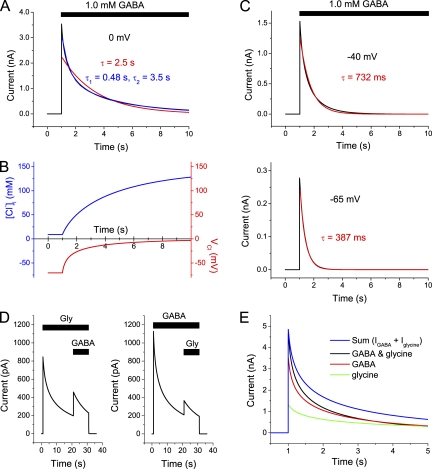Figure 8.
Computed currents decay rapidly in the absence of true desensitization. (A) Computed current evoked by 1.0 mM GABA in the absence of decay in conductance. Vm = 0 mV. Time constants for fitted mono-exponential (red) and bi-exponential (blue), as shown. (B) Computed change in [Cl−]i (blue) and VCl (red) during the current in A. (C) Computed currents, with superimposed fitted mono-exponentials. As in A, except voltage = −40 mV (top) and −65 mV (bottom). Note the faster decay at more negative voltages. (D) Apparent cross-desensitization between GABA- and glycine-evoked currents, expected from changes in [Cl−]i, under conditions corresponding to those used experimentally for the records in Fig. 2 B (top). Maximum conductances were set to match those observed without pre-applied agonist, and the cell was approximated by a sphere of radius of 9.0 µm. (E) Computed currents evoked by 1.0 mM GABA (red), 3.0 mM glycine (green), and coapplication of GABA and glycine (black) at 0 mV, without true desensitization. Maximum conductances for GABA and glycine were set to match the experimental responses to each agonist illustrated in Fig. 3 B. No adjustment of kinetics was made. Note that after peak current, there is a deviation of current at coapplication (black) from the sum of responses to each agonist (blue), as experimentally observed in Fig. 3 B. Cell approximated by a sphere of radius of 5.5 µm.

